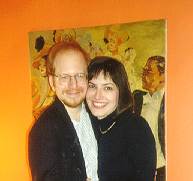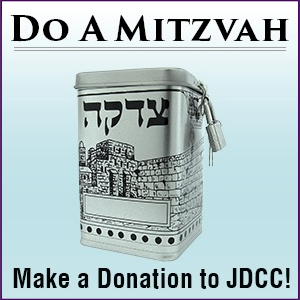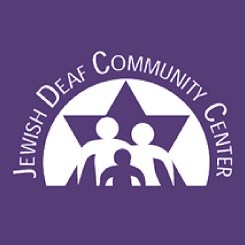 This is a new column devoted to our Jewish Hearing Friends involved in the Deaf Community.
This is a new column devoted to our Jewish Hearing Friends involved in the Deaf Community.
Naomi Brunnlehrman
New York
Naomi is one of the rare interpreter who can listen to Hebrew and translate it into ASL. She has been involved in the Jewish Deaf Community for a long time and is currently a graduate student at the Jewish Theological Seminary which is part of the Conservative branch of Judaism in New York.
Naomi with husband Steven
How And When Did You Get Involved In The Jewish Deaf Community?
Years ago when I was in high school, I volunteered at St. Mary’s School For the Deaf in Buffalo, N.Y. It was then that I decided to get involved in the Jewish Deaf community because it bothered me that the Jewish students had little or no access to a quality Jewish education. In fact one of the Christian volunteers tried to convince me to convert to Christianity!
While I wanted to study ASL in college, there were no courses at my university (State University of New York at Albany) taught by Deaf teachers. So after college, as I moved from Albany to Boston to Florida, I volunteered in the Deaf community. In Boca Raton, Florida I co-founded (with a Deaf colleague) a Jewish Young Adult Deaf Group (CBID = Congregation B’nai Israel’s Group of the Deaf), and that group is still active today with Deaf leadership.
In 1993, I decided to move to New York City to immerse myself in the Deaf world hoping that I would find a colleague who is Deaf that would be interested in working together to strengthen the ties between the greater Jewish community and the Deaf community. I was very fortunate to meet Maria Berkowitz, and together we cofounded MYAJD (Manhattan’s Young Adult Jewish Deaf Group) which is now an affiliate of our international 501 (c)(3) organization called The Jewish Deaf Resource Center, Inc.
Where Did You Learn To Sign?
My first Sign Language class was unfortunately not an ASL class. In exchange for my volunteering at St. Mary’s School For the Deaf, they allowed me to attend for free a Sign Language class taught by a hearing high school teacher who admitted that she was currently learning how to sign from her Deaf high school students. I remember even then being bothered that Deaf kids had to teach their hearing teachers how to sign. It wasn’t until I started socializing in Deaf clubs in Albany, Boston and Florida that I started to learn ASL.
How Were You Able To Combine Your Hebrew Skills And Incorporate Them Into Sign Language Such As Transliteration Of Hebrew Sign Language?
I started attending Jewish Day School when I was very young, before I was even old enough to be admitted to public school. So, at first I was having a difficult time reading both Hebrew and English because I was really young. My Hebrew teacher told my mom that I would never learn to read Hebrew and my mom was convinced that I had the ability and that the teacher was incorrect. So my parents hired a private Hebrew tutor for me and Hebrew became my first reading language. As the years went by, I ended up being a better student in Hebrew than in English.
In high school and college, I continued to study not only Hebrew but Judaic texts such as Bible and Mishnah etc. My minor in college was Judaic Studies and I am now a part time graduate (MA) student in the Interdepartmental Judaic Studies program at The Jewish Theological Seminary (JTS). As part of my current studies I have specialized in Jewish Liturgy.
So when I attended an ASL Interpreter Training Program (1995 -1997), it was natural for me to interpret directly from Hebrew to ASL. I was also fortunate to have a Deaf ASL teacher here in New York named Carole Lazorisak who encouraged me to interpret directly from Hebrew to ASL. Additionally there were several Jewish Deaf people who encouraged me to work in synagogues because they thought I might be able to create a more meaning based interpretation since I am so familiar with the liturgy. They really pushed me to share my knowledge and to improve my skills as a Hebrew to ASL Interpreter. So I began to study privately with Deaf people as well as hearing ASL Interpreters to improve my ability to interpret from Hebrew to ASL. Honestly, I find it easier to interpret from Hebrew to ASL than English to ASL.
My understanding from my recent trip to Israel is that Hebrew Sign is really an equivalent of what we call PSE here. It isn’t really a language. ISL (Israeli Sign Language) which is comparable to our ASL, is indeed a full language with morphemes and syntax etc. I have not found Hebrew ~transliteration” to be effective in conveying meaning, and I do believe that, as an ASL Interpreter, it is my job to convey meaning.
What Are You Majoring In At JTS And What Do You Hope To Do When You Are Done?
I have not yet met a professional ASL Interpreter who has advanced graduate training in Judaic texts. I think that just as we have professional ASL Interpreters who specialize in legal interpreting or medical interpreting or Spanish interpreting, so, too, we need professional ASL Interpreters who are academically trained in the languages and cultures of our liturgy (prayers) and Bible (including Prophets) so that we can better convey meaning from Hebrew to ASL, and by so doing improve the connection (the kesher) that Jews who are Deaf have with Judaic texts, God, and the Jewish community.
What Do You Hope To See In The Future Of The Jewish Deaf Community?
I would like Jews who are Deaf to have the same choices that I have as a hearing Jew. It saddens me when Jews who are Deaf describe how they can’t consider the rabbinate, or Jewish education as a career because of their lack of access to a quality Jewish Education on a graduate or rabbinic level.
I would like to see Jews who are Deaf have regular access to synagogue services so that they can become more involved in the training of ASL Interpreters who work in Jewish settings. I would like to see Jewish Deaf Education in the USA nun by academically trained Jewish Deaf educators (instead of hearing professionals), and I would like to see Jewish Deaf leaders consulting Jewish hearing organizations. Although I think everyone’s intentions are good, I am not comfortable when ASL Interpreters or hearing rabbis consult national Jewish organizations without Jewish Deaf adult leaders taking the lead and being active partners in the decision making process.
Tips?
I think that the greatest gift hearing people can give the Deaf community is to do our best to put ourselves out of a job and out of the limelight. Many Jewish organizations call upon hearing professionals who work with the Jewish Deaf community when questions arise. How many presidents of Jewish organizations know the names of Jewish Deaf leaders whom they could contact directly if they had a question?
As an ASL Interpreter, I think our job is to provide the information that is needed so that Deaf people can become our rabbis and our teachers instead of the other way around. As an ASL interpreter in a Jewish setting, I think there are NO shortcuts to the importance of study. I believe we should be studying with the most professional and the most skilled Deaf and hearing ASL Interpreter Trainers as well as continuing our studies in Liturgical and Biblical Hebrew and Judaic texts. I think we need to regularly study with the Deaf community and share our questions with them. This means if we don’t know something we need to be honest about it. There is nothing wrong with not knowing and needing to learn. The challenge is that many times people think we know information and we don’t want to admit that we don’t.
Your Biggest Challenge?
My biggest challenge is that I myself still have so much to learn especially about ASL and the skill of interpreting. It is a blessing and a sacred privilege to be continuously learning and working side-by-side with the Deaf community.





